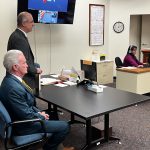AVALON – A series of winter storms that eroded areas of the north end beaches, especially in the area of 9th Street, has confirmed the need for an already planned borough project to bring new sand to those beaches before summer.
Business Administrator Scott Wahl, speaking at the Borough Council’s Wednesday, Jan. 10, work session, said the recent federal hydraulic beach fill had brought the beaches back to the Army Corps of Engineers template level, but that an active winter storm season has produced erosion in the most vulnerable area of the borough’s beaches, the north end.
Wahl said that the erosion of the beaches around 9th and 10th streets had begun to expose the dunes to erosion threats.
Avalon has a 50-year agreement with the Army Corps for hydraulic fills on its beaches, usually on three-year cycles. The borough frequently engages in back passing projects, moving sand from one section of the beach to another, that truck sand from an approved borrow area between 32nd and 38th streets to the most frequently eroded areas of the north end during the intervening years.
Wahl explained that Avalon sets aside funds each year for beach repair and bay dredging needs. In past years the back passing was carried out by the borough’s Department of Public Works. Since the pandemic, Wahl said, it has been difficult for the borough to find vendors with available heavy equipment for rent for projects of short duration. This has led the borough to outsource the project, as it will do again this year.
The administrator said the schedule calls for a request for bids going out in mid-March and an award of a contract in mid-April.
The borough’s state-approved borrow area is a location where sand has eroded in the north of town and reentered the beach from sand bars just offshore, near the midpoint of the municipality. Wahl said the accumulation of sand just off the dry beach area has meant that recent back passing efforts have not been needed to remove sand from the dry beach.
Borough Engineer Thomas Thornton of Mott MacDonald told the council that the town’s existing permits from the state and the Army Corps would allow for the 2024 back passing, but he added that the period of viability for those permits ends in 2024. He presented a proposal for renewal of the permits, often an involved process.
Wahl said that the amount of sand that will be needed in the back passing has not yet been determined and may not be until after the winter storms subside. Another factor in determining the size of the back passing effort will be the level of available sand in the mid-borough borrow area.
Commenting on the federal beach fill, which is critical to the maintenance of the borough’s engineered beaches, Wahl said that this year funds for that beach replenishment effort included an allocation for the exploration of a potential new borrow area offshore and not part of Townsend’s Inlet, which has traditionally supplied the sand for the hydraulic fills.
Wahl recounted the series of federal decisions that have resulted in a ban on the removal of sand from Hereford Inlet, which had supplied sand for beach projects in Stone Harbor in the past. The unavailability of sand from Hereford Inlet has twice led the Army Corps to use a more expensive process for piping sand from Townsend’s Inlet the full length of Seven Mile Island to rebuild beaches in neighboring Stone Harbor.
This heavy reliance on sand from Townsend’s Inlet could pose problems in the future. Wahl said there are two factors that impact the federal hydraulic beach fills – funding and the availability of sand from the inlet. Finding a new offshore borrow area would potentially ease the burden of sand for Stone Harbor and possibly for North Wildwood replenishments while relieving the burden of sand availability from Townsend’s Inlet for all of the projects.
The late spring schedule for Avalon’s back passing project was a subject Wahl also addressed. He said the schedule would allow the borough to hit the “sweet spot” of replenishing the eroded areas in May and possibly early June. This minimizes the time the redirected sand is vulnerable to new storms prior to the busiest months of summer.
Contact the author, Vince Conti, at vconti@cmcherald.com.








